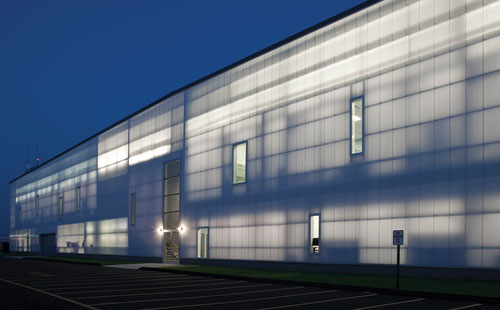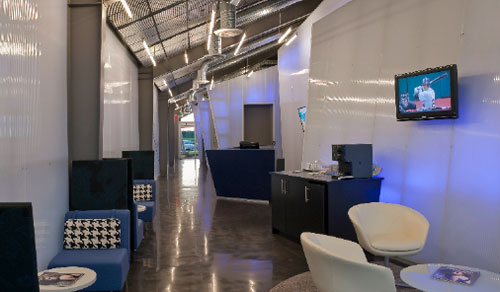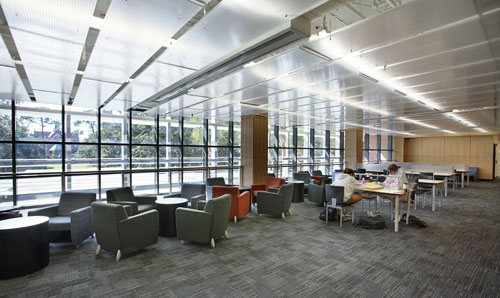Translucent Cellular Polycarbonate Delivers Design Versatility
Lightweight, insulating and translucent, cellular polycarbonate has wide applications.
![]() Continuing Education
Continuing Education
Use the following learning objectives to focus your study while reading this month’s Continuing Education article.
Learning Objectives - After reading this article, you will be able to:
- List the properties of cellular polycarbonate structural sheeting and how they contribute to energy savings and daylighting.
- Summarize the sustainability advantages of cellular polycarbonate over other glazing materials.
- Describe framing and fastening systems for different cellular polycarbonate profiles and how they support architectural design goals.
- Identify safety, light and heat transmission performance standards relating to cellular polycarbonate material.
Cellular or multiwall polycarbonate has been a major building material for architects in Europe (and other parts of the world) but is only now being understood in the U.S. for its many virtues and limitations. Gone are the days when polycarbonate sheets were associated with inexpensive plastic panels that yellowed with age. Now most cellular panels not only receive a UV-resistant coating to eliminate yellowing, but are available in a wide range of thicknesses, structural strengths and configurations that also help meet LEED® requirements.
Since cellular polycarbonate—or polycarbonate structural sheet (PCSS) as the material is generically known—offers architects a multitude of design solutions for canopies, barrel vaults, skylights, translucent walls and signage, familiarity with its characteristics, benefits and appropriate use is essential. But equally critical to a successful application is a framing and fastening design that meets both the technical requirements of PCSS and the aesthetic goals of the design team. Since some manufacturers have the knowledge and experience of framing their products, they can, and do, play an instrumental role in solving technical problems—particularly for innovative projects. More than one design firm credits the input of the PCSS manufacturer/fabricator for the success of an award-winning project.
What is a Polycarbonate
Structural Sheet (PCSS)?
Polycarbonates, named because they are polymers containing carbonate groups (-O-(C=O)-O-), are a widely used plastic made from a particular group of thermoplastic polymers. Unlike monolithic polycarbonate, which has no internal cavities, PCSS is available with multiple honeycomb-like cavities commonly known as “flutes.” All such polycarbonates are versatile due to their high impact resistance, optical properties, temperature and fire resistance.
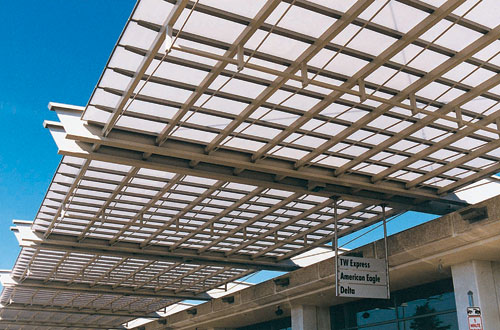 |
For the Gerald R. Ford International Airport in Grand Rapids, Mich., HOK specified cellular polycarbonate for this 575-ft-long canopy. Low slope problems were solved by using 27-ft-long one-piece panels. |
Extrusion Technology
PCSS is manufactured using extrusion technology. Plastic resin in the form of clear or tinted pellets is melted and pumped through a die. After traveling through the die, the sheets enter a heated oven to relieve tension. They then travel over a series of rollers, are cooled and cut to the final dimensions. This technology allows for the continuous production of any length of product in a wide variety of profiles that is limited only by its ability to be transported. For sheets coming from overseas, the maximum length is 39 ft. That is all that will fit into a 40-ft container. However, manufacturers in the U.S. are beginning to extrude locally and will be bound only by the length of a truck bed.
Key to manufacturing polycarbonate profiles are sophisticated dies that set the width, height, thickness and structure according to the particular specifications of design professionals.
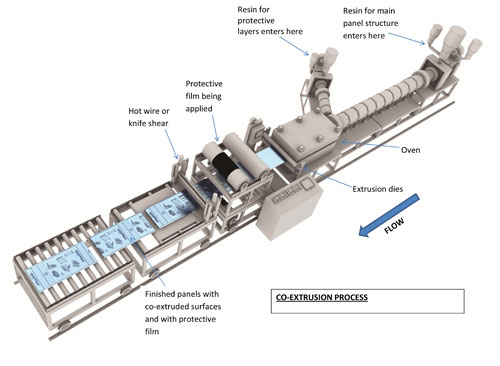 |
Co-extrusion machines adds a UV protection layer to extruded polycarbonate. Image courtesy of EXTECH/Exterior Technologies, Inc. |
Co-Extrusion Technology
Co-extrusion technology involves adding a thin layer of a different resin mixture to one or both sides of extruded polycarbonate to create different end products. The added material can serve as an ultraviolet light (UV) protection layer since UV rays can discolor unprotected polycarbonate. The co-extruded resin can also serve as a means to color a sheet or as a means to add improved solar heat-rejecting performance.
PCSS Profiles
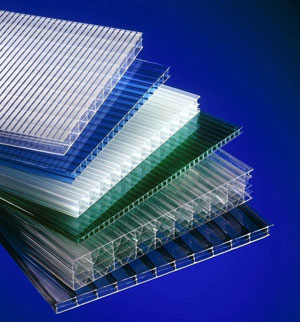 |
Cellular polycarbonate structural sheets (PCSS) are manufactured in a variety of profiles. Photo courtesy of EXTECH/Exterior Technologies, Inc. |
All PCSS sheets are flat except for special profiles such as standing seam panels. They are all flexible and can be cold bent to suit design requirements. The length and width of PCSS flat sheeting can be adjusted to meet specific customer requirements. Standard sheeting sizes in the U.S. are 4 ft or 6 ft wide with a maximum length of 39 ft if they are coming by container and longer if they are produced in the U.S. and can be delivered via truck. These lengths are also true for specially profiled sheets such as standing seam or tongue and groove.
PCSS Cellular/Multiwall Flat Sheet
Polycarbonate structural sheets (PCSS) are fabricated in many configurations such as three-wall, five-wall and five-wall x-structure, among others. These multiwall sheets can be used as a standard glazing material and, on rare occasion, can be cut to size on site. Applications include greenhouses and signage (usually 6mm and 8mm thick), office dividers and dropped ceilings (usually 16mm). High-impact or heavy snow/wind load applications, such as curtain walls and skylights, will require panels of 16mm, 20mm, 25mm, 32mm, 40mm or 50mm thickness. These thicker panels also offer higher insulating value.
Standing Seam
Standing seam sheets, commonly used for skylights, canopies and wall systems, are typically available in nominal 2-ft widths. More specifically, owing to their European heritage, they are 600mm (23.62 in.) wide. The available lengths are as stated above for PCSS flat sheets. Typically, standing seam systems have polycarbonate battens, which snap over the sheet edges and form the seams. This is the same design that has made standing seam roofing so successful. Aluminum battens can be used if extra spanning capability is desired. The standing seam panels are secured to the substrate (normally purlins or girts) with metal clips. Some manufacturers offer two-piece metal clips which are designed to accept the thermal movement of the panels as well as reducing noise from friction.
 |
Polycarbonate battens snap PCSS sheets together in a standing seam profile. Hidden clips, which engage the panels at the seams, secure the panels to the substrate. Photo courtesy of EXTECH/Exterior Technologies, Inc. |
Tongue and Groove
A tongue and groove profile is used for vertical walls, office dividers and industrial windows. Joints, which have no battens of any kind, create a visually uninterrupted wall. Tongue and groove panels are typically available in 40mm or 50mm thicknesses. Some panel configurations allow the insertion of steel bars, typically 3/16 in. x 1-1/4 in., and as long as the panel. These bars increase the spanning capability of the panels.
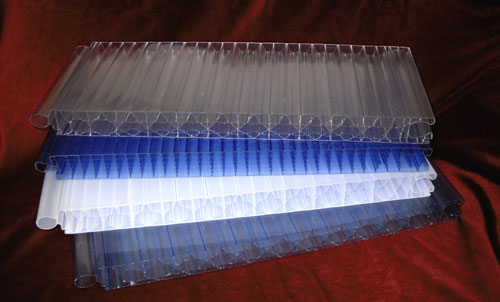 |
|
Photo courtesy of EXTECH/Exterior Technologies, Inc. |
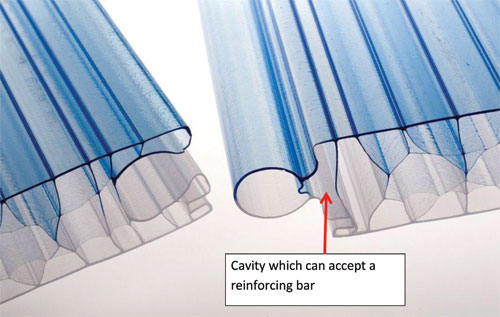 |
PCSS tongue and groove profile provides a seamless connection with no protruding battens or caps. Photo courtesy of EXTECH/Exterior Technologies, Inc. |
Tongue and groove cellular polycarbonate panelsVolo Aviation at Igor I. Sikorsky Memorial Airport |
||
|
||
|
Designed by Beinfield Architecture PC of South Norwalk, Conn., Volo Aviation at Igor I. Sikorsky Memorial Airport, Stratford, Conn., is a facility for a jet leasing company. Among other functions, it is a hangar for jets. The design challenge was to provide a unique and affordable façade along the 270-ft by 38-ft front face of this typical pre-manufactured steel frame structure. A polycarbonate cladding system was selected that allows diffused natural light into the offices during the day and inverts the effect with internal lighting at night. The exterior PCSS cladding is a tongue and groove panel system that is highly impact resistant and has high thermal insulation properties. The panels come in 20-in. widths and maximum 39-ft lengths. They run vertically with an average height of 38 ft and are fixed to the horizontal steel girts of the pre-manufactured structure via special clips. These clips are designed to allow thermal movement of the panels. The polycarbonate systems manufacturer provided custom aluminum trim at the heads and sills of the polycarbonate facades. The trim also allows for the expansion and contraction of the polycarbonate wall system. The passenger waiting area is essentially a series of translucent polycarbonate interior partitions. The polycarbonate captures light from the LED light source and refracts it within its cells, giving the entire wall an ambient glow. |
Polycarbonate Properties & Performance
Because of their versatile properties, which position them between commodity plastics and engineering plastics, the second largest use of polycarbonates is for construction material (the first is for electronics components). A testament to the strength of polycarbonate is the fact that airplane windows are made of it.
Clarity/Light Transmission/Daylighting
Clear PCSS allows more light transmission than fiberglass reinforced panels (FRP). Soft, even daylighting can be achieved through opal or frosted polycarbonates. Studies have found that access to daylight enhances well being and quality of life. Daylighting is also linked to improved learning, increased retail sales and office worker productivity.1
Students with the most daylighting in their classrooms progress faster on math (20 percent) and reading tests (26 percent) than those with the least light in their classrooms. Another study found that diffused daylighting increased retail sales—up to 40 percent for one major retailer. Further, other research reports that call center workers handled calls 6 to 12 percent faster, while office workers tested 10 to 25 percent better when compared with those working in less natural light. Glare, from any source, potentially decreased office worker performance by 15 percent to 21 percent.
Impact Resistance
PCSS products offer high impact resistance and protection against storm damage and vandalism. Some polycarbonate glazed systems have met the product testing requirements of Florida, Miami-Dade and Texas Building Codes. However, many of those systems require close spacing of framing or other reinforcement, which may raise aesthetic issues.
In some applications PCSS has been demonstrated to be practically unbreakable. Polycarbonate is 250 times more impact resistant than an equivalent thickness of annealed glass and 30 times more than that of non-modified acrylic.
A PCSS surface is softer than that of glass and its structure is more crushable than glass. To address this, some manufacturers incorporate special framing designs to restrict the pressure of the gasketing against the polycarbonate. This is called “controlled gasket pressure.”
Energy Savings
PCSS offers significant benefits in thermal insulation due to the many airspaces between the inner and outer panel faces. Because of the variety of available profiles and resins, it can deliver high levels of light transmission while also maintaining high R-values (thermal resistance.)
One inch of cellular polycarbonate, compared with one inch of insulated glass, has an R-value of 3.84 compared with 2.08 for the glass. Their U-values (rate of heat loss which is the inverse of the R-value) are 0.26 and 0.48 respectively.
Significantly increased thermal performance may be achieved by combining polycarbonates with translucent aerogel, a substance derived from a gel in which the liquid component of the gel has been replaced with a gas.
Aerogel manufacturers claim:
* High light transmission
* Non-combustible
* Totally recyclable
* Non-toxic
* Silica gel–97% air
* Hydrophobic
However, it should be noted that aerogel fillings in cellular polycarbonate are a relatively new item and long-term field performance has yet to be established.
Resistance to Flame/Heat and Smoke
Smoke density, flame spread and self-combustion measurements are all important factors when describing the safety performance of all plastics. When considering these factors, PCSS offers much better results than either FRP or acrylic.
PCSS in various profiles are typically available as Class A-, B- or C-rated materials for flame spread and smoke generation (see sidebar Standards and Definitions.) Properties of PCSS include:
* Self-ignition temperature >842° F (450° C) {Note: IBC 2606.7 requires plastic materials to have a self ignition temperature of 650° F (343° C ) or greater.} * Softening temperature point: 320° F (160° C) (this meets International Code Council acceptance criteria) * Decomposition occurs at approximately 715° F (380° C)
UV Resistance and Yellowing
Sheet degradation is measured using a yellowness index, ∆YI, calculated from spectrophotometric data that describes the change in color of a test sample from clear or white toward yellow. In addition to change in color, ∆YI correlates with a proportionate amount of loss of the sheet's ability to transmit light. A ∆YI over 5 will also have a reduced impact resistance. Different warranties for polycarbonate products reflect the effectiveness of UV protection. When evaluating polycarbonate sheet materials for use as glazing, design professionals should compare warranties to see which offers the best protection against yellowing, impact resistance and light transmission degradation. Most current architectural panels qualify for a ∆YI of 2 or less even after the equivalent of 10 years in a south-facing application.
 |
Examples of multiwall polycarbonate yellowing indices (ΔYI) Image courtesy of EXTECH/Exterior Technologies, Inc |
Cellular Polycarbonate Suspended Ceiling: |
||
For the ceilings of the 117,000-sq-ft renovation of the University of Florida Library West, Ross Barney Architects of Chicago, Ill., and partners Long & Associates Architects/ Engineers, Inc., Tampa, Fla., chose cellular polycarbonate panels. The standing seam panels were suspended via small cables and clips at each corner. The panels were placed with a nominal 3-in. space between them so that maintenance personnel could easily unhook them or simply push them to one side to reach above and change light bulbs. “It was a very simple solution,” says principal-in-charge Michael A. Ross, AIA, LEED AP. The separations also aided the acoustic value of the ceiling. In some areas, the architect used the linear configuration of the panels to provide directional cues to different parts of the library. |
Thermally Dynamic Material
Polycarbonate expands and contracts thermally more than most materials (about seven times as much as glass or steel and about three times as much as aluminum). It even moves with the temperature differential that occurs from day to night. Thermally induced expansion and contraction of PCSS can amount to 1/8-in. per 3 ft per 100-degree temperature change. Some manufacturers compensate for this by designing retention clips and framing that allows for sheet movement (see Framing below.)
Engineered framing and clip designs can also eliminate sounds caused by the expansion or contraction of PCSS panels.
LED Lighting
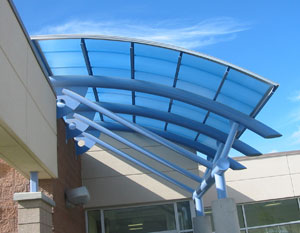 |
MHTN Architects, Salt Lake City, Utah, designed a series of cold-curved blue cellular polycarbonate canopies for the Rose Springs Elementary School in Tooela, Utah. Photo by Dave Bardsley |
PCSS lends itself to interior applications where background lighting is desired. The cellular, fluted structure diffuses the light and, in some applications, causes the light to “run up” the flutes. It is even possible to incorporate “rope” LED lighting into the flutes themselves.
Lightweight
A 1-in.-thick piece of cellular polycarbonate weighs approximately 0.65 lb/sq ft compared to 6.25 lb/sq ft for 1 in. of insulated glass. This difference is so dramatic that buildings that incorporate PCSS skylights or canopies can be built with lighter, less expensive framing systems. Light weight also offers significant savings in transportation, handling and installation.
Cold Bending
PCSS can be cold bent (curved) lengthwise, usually over a series of supports which are spaced so as to determine the curvature. Once a sheet is removed from its form, it will regain its flat profile. Cold bent polycarbonate is a solution for applications such as canopies and barrel vault skylights. It should be noted that curving also adds significant spanning strength to the panels. Specifiers should be aware that over-bending may constitute a breach of warranty.
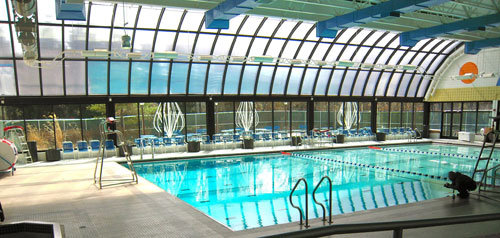 |
Example of a barrel vault skylights with curved cold bent PCSS panels held by aluminum battens. Photo by Cameron Duncan, AIA |
Table of Bending Radii |
||||||||||||||
|
||||||||||||||
Acoustical and Sound Transmission Limitations
PCSS tends to reflect sound more than alternate materials that have softer and more textured surfaces. It must be used carefully for interiors. Manufacturer's product data sheets note the decibel level (dB) or level of transmission of sound for different thicknesses. A three-wall, 25mm PCSS sheet, for instance, has a 22-dB value (a bird call is 40 dB).
Easy to Clean
PCSS products are easily cleaned using detergent and water or power washing. However, one of the virtues of PCSS is that, owing to the light-diffusing nature of the multi-cells, it doesn't show the dirt. This same quality hides scratching or other imperfections. While glass glazing requires periodic cleaning, PCSS glazing is seldom cleaned—thus providing considerable maintenance savings.
Anti-Condensation
Water droplets on the inside surface of polycarbonate glazing (or any other glazing material) will reduce light transmission and, if the droplets fall, they can damage greenhouse plants, sensitive goods and equipment below. Anti-condensation PCSS sheets are available to which a surfactant coating has been applied. Surfactants are chemicals which cause water to spread out across a surface. This helps prevent the dripping of water droplets, while allowing a thin layer of water to run off the polycarbonate sheet without affecting light transmission. This is a technology which is used mostly in greenhouses.
Interior Panel Condensation
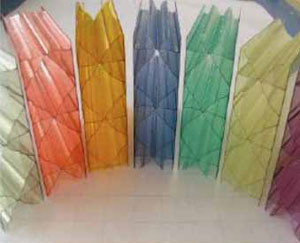 |
Virtually any color can be provided, given sufficient quantity. However, the common colors are clear, opal and bronze tint. Photo courtesy of EXTECH/Exterior Technologies, Inc |
PCSS is known to allow condensation to build up inside the flutes under certain circumstances. Polycarbonate, unlike glass, is not a total vapor barrier. If PCSS is exposed for a long time to hot, humid air and then is exposed to significantly colder air, condensation can appear within the flutes (usually in only some flutes and normally near the bottom of the panel). Typically, this condensation dissipates within a day or two as the vapor level equalizes. To aid dissipation, some manufacturers place venting tape over the ends of the panels so as to allow small amounts of air to circulate within the flutes.
LEED® Benefits
Polycarbonates can contribute to LEED® points in Energy and Atmosphere, Materials and Resources, Indoor Environmental Quality and Innovation in Design categories. The bases for points are: * 100 percent recyclable material. Many companies use up to 20 percent post-consumer recycled materials in manufacturing polycarbonate, depending on the performance and clarity needs of the project. * Provide large horizontal and vertical expanses of daylighting. * Energy efficiency can be measured and verified using manufacturers' product data sheets. * Panels are lightweight and require less structural support. * Reduced transportation costs.
Design Versatility
PCSS offers design professionals many options for a multitude of applications:* Color choices range from clear, opal and blue to green, bronze, custom and dual-colors (one color on the inside and another on the outside). * Typical textures include smooth sheen or hammered crystal. * Wide range of thicknesses and structural strengths. * High strength and lighter weight allow longer spans and less support. * Sheets are easily curved using cold bending.
Framing (Improper installation)
As noted above, correct framing and fastening are critical for long-term installations of PCSS panels. Design professionals should seek input from manufacturers/fabricators on how framing and fastening details will compensate for PCSS properties such as soft surfaces and thermal movement—particularly if the project presents an innovative use of multiwall polycarbonate.
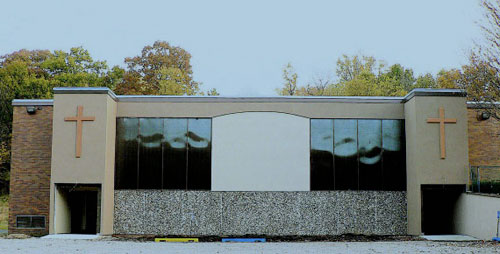 |
The warping of the panels in this photo resulted from the use of perimeter framing which did not have sufficiently deep rabbets. Panels must be made long enough to stay engaged in cold weather. In the case of shallow rabbets, that makes them “bottom out” when they expand in hot weather. The solution is deep rabbets coupled with glazing that is cut to the proper length by the fabricator. Photo courtesy of EXTECH/Exterior Technologies, Inc |
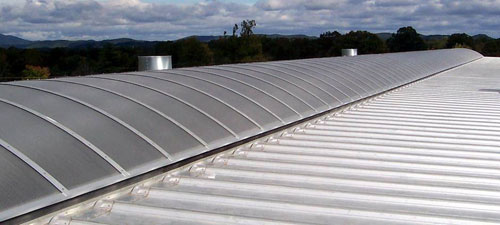 |
Elkamet Corporation, East Flat Rock, N.C., exemplifies proper framing and fastening of cold curved sheets. Photo courtesy of EXTECH/Exterior Technologies, Inc |
Designing the Frame
With their knowledge of dies and extrusion processes, many PCSS fabricators or integrators are well positioned to offer advice regarding extruded aluminum framing and gasketing and the engineering of systems.
Experienced manufacturers incorporate three features into every framing system: deep channels (known in the industry as “rabbets”) in the framing to accept expansion; gaskets with low friction surfaces to minimize wear (and noise) resulting from expansion and contraction; and, to compensate for soft PCSS surfaces, controlled gasket pressure. This is accomplished by rigidly spacing the framing at a specific distance apart on each side of each PCSS panel.
 |
In this example of proper framing for PCSS architectural systems, the plastic spacer acts as a thermal break and also limits how tightly the gasketing will press against the panel. This is known as "controlled gasket pressure." Image courtesy of EXTECH/Exterior Technologies, Inc |
 |
This is an example of a sophisticated system wherein the vertical and horizontal framing members are joined by a single stainless steel pin. However, the principle of lapping framing members can be employed with more conventional systems also. Overlapping joints, as shown in this example, give superior strength and weathertightness. Image courtesy of EXTECH/Exterior Technologies, Inc |
 |
This is the same system as shown in the exploded view, now shown assembled. The ability to overlap framing members was made possible by the use of two different thicknesses of gasketing. Image courtesy of EXTECH/Exterior Technologies, Inc |
| Standing Seam Framing System | Tongue and Groove Framing System |

|
|
Standing seam systems include battens which snap over the upraised legs of the two adjoining panels. This assembly is secured to the substrate by clips, typically made of aluminum or stainless steel. The most sophisticated clips are made in two pieces such that the upper portion can "travel" with the panel during expansion and the lower portion will remain fixed to the substrate. These are called "articulated clips." |
Window/curtainwall framing details for 40mm PCSS panels. Alternative framing system will Image courtesy of EXTECH/Exterior Technologies, Inc. |
Advantages of Polycarbonate Over Glass: |
The benefits of choosing a polycarbonate system over a glass system include:
|
| Advantages of Polycarbonate Instead of Fiberglass Reinforced Polyester (FRP) Systems: |
|
Performance Standards and Definitions Relating to Polycarbonate In addition to weight, sound transmission and U/R-value, typical manufacturer’s description will include values for light transmission, shading coefficient, solar heat gain coefficient and direct solar transmission. *Light Transmission (LT)Percentage of incident visible light that passes through the sheet. Tests to determine percentage Light Transmission: ISO 9050, EN 410 D65 (380-780 nm) * Visible Light Transmission (VLT)A measure of the amount of visible light that passes through the sheet. A product with a higher visible light (VT) transmits more visible light. VT is expressed as a number between 0 and 1, 0.5 meaning 50 percent light transmission. * Shading CoefficientA measure of the ability of a window or skylight to transmit solar energy. Currently being phased out in favor of Solar Heat Gain Coefficient (SHGC, below.) It is approximately equal to SHGC multiplied by 1.15. Shading coefficient is expressed by a number between 0 and 1. The lower the shading coefficient, the less solar heat it transmits and the greater its shading ability. A low shading coefficient in combination with a high LT percentage and transparency is usually desirable. * Solar Heat Gain Coefficient (SHGC)A measure of how well a window or skylight blocks heat from sunlight. The SHGC is the fraction of the heat from the sun that enters through a window. SHGC is expressed as a number between 0 and 1. The lower a window’s SHGC, the less solar heat it transmits. * Flame Spread Rating (FSR) and Smoke-Developed Index (SDI)The American Society for Testing and Materials (ASTM) Test Method E-84 (Steiner tunnel test) measures how far and how fast flames spread across the surface of the test sample and how much smoke is generated. FSR is expressed as a number on a continuous scale where inorganic reinforced cement board is 0 and red oak is 100. The most common classifications are: Class I, also called A, with a 0-25 FSR; Class II or B with a 26-75 FSR; and Class III or C with a 76-200 FSR. A smoke-developed index not to exceed 450 is required by IBC section 803.1 for interior wall and ceiling finishes classes A, B and C. * ASTM D635-06 Test Method for Rate of Burning of Plasticsis required by IBC for light transmitting plastics only. This test is limited to a small scale flame test and does not include a Smoke Test.
|
||||||||||||||||||||||||||||||||||||||||||||
Conclusion
Cellular or multiwall (PCSS) polycarbonate panels offer considerable versatility for design professionals seeking solutions for canopies, barrel vaults, skylights, translucent walls and signage. Its benefits range from translucency and impact resistance to energy savings and flame and heat resistance. It also can contribute to LEED® points. The key to successful applications is a well-engineered framing system that addresses all of the nuances of this significant and timely building material.
 |
EXTECH/Exterior Technologies, Inc. is a group of engineers and architects and shop gearheads who design and fabricate (and sometimes install) daylighting systems and custom facades and who support architects and building owners. EXTECH holds 13 patents for systems and components for canopies, skylights and walls. www.extechinc.com
|

